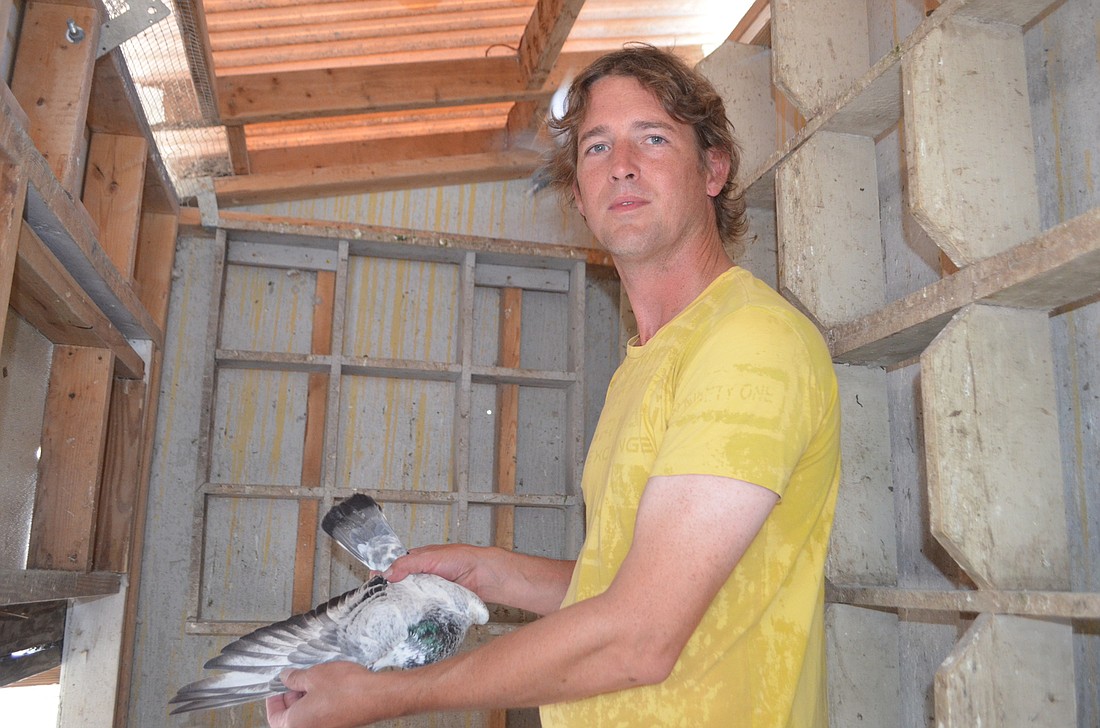- April 15, 2024
-
-
Loading

Loading

If Myakka City's Charles Cole ever changes his mind, and wants to get out of the sport of pigeon racing, he might be in trouble.
When it comes to pigeon racing, there is no going back. Well, unless you are a pigeon.
"Once you start taking care of them, you can try to get rid of them, but they just come back," Cole said. "You can transport them thousands of miles away, and then they'll be back on your doorstep in a few days. It looks like I am stuck with pigeons."
That's OK with Cole, who has become absorbed in the sport.
After serving with the U.S. Army in Iraq in 2003-2004 and then living in Germany in 2005, Cole moved back to the United States and lived in downtown Sarasota for a while before eventually moving to Myakka City. Now 39, Cole enjoys the farm life.
“My dad (Charles Cole) did it when I was a kid, and I remember it being a pain,” Cole said of farming. “When I came back from Germany in April of 2005, I thought I was missing something in my life, then I thought to myself, I need some pigeons.”
He got them. Cole has 50 pigeons to go with a dog and two horses. Cole joined the Sarasota Pigeon Club four years ago.
Most members of the Sarasota Pigeon Club are seniors, including the oldest member, 93-year-old Ralf Serpi, but Cole gives hope the club will survive into the future.
The sport's popularity has waned according to Sarasota's Charlie Busack, 63, one of the club's founders.
“The numbers are going down because it’s harder to get young people to get involved,” Busack said. “That’s probably because it’s time consuming, and it’s something you have to do everyday that doesn’t involve a computer. Young people today don’t want to do things that require the dedication that pigeon flying does.”
The eight members of the Sarasota Pigeon Club meet for 10 consecutive Friday nights during each season, which runs from September through December for the younger birds fly up to 300 miles, and February through April for the older birds that fly up to 500 miles.
On Nov. 25, a truck made stops in Naples, Fort Myers, Port Charlotte and Sarasota to picking up all of the pigeons from the various Floridian clubs for a race. Cole's racers were among them.
Each individual pigeon is armed with an electronic device that is wrapped around its leg. This device tracks the distance and time it takes each bird to get back to its loft, giving the members the average speed of their birds.
On Saturday evenings during the racing season, each club gets together and determines the winner of the race, and then moves on to the next race.
The number of birds each member races depends on the owners. Some of the members breed more birds than others.
“Some guys breed about 100 a year,” Cole said. “I try to breed 50 a year. And other guys do 20. When you have less birds, it’s easier to keep up with every single one of them individually.
"But if something happens, and a hawk or raccoon gets to them, then you have a smaller amount of pigeons to race. Everyone has different ways of handling their own flock.”
Pigeon purse money can run into thousands of dollars for a race, but many of the pigeon racers, like Cole, do it as a hobby simply because it’s fun.
Sarasota's Jeff Sarmiento, 55, said it's another form of competition.
“I started racing when I was in sixth grade," Sarmiento said. "Once you get it in your blood, it’s hard to get rid of it. Training is work, breeding is work and cleaning is work. But the racing is fun.
"Once the trailer leaves with your pigeons, you get to sit out there the next day and just watch the sky, wondering when the birds are going to come. It’s exciting.”
Cole is passionate about the sport because of the training.
“You start breeding in late December, then the first race is the last week of September," Cole said. "You spend nine months breeding and training before the first race. Then, when you get a bunch back from their first race, if some even seem to have a good time, you feel like you’ve accomplished something.”
Even homing pigeons need practice. The trainers take them five miles away and turn them loose, then 10 miles and gradually increase the distance to more than 50 miles.
Like any sport, training makes a big difference between winners and losers.
“Winning races is my favorite part of the sport,” Busack said. “The part that’s most enjoyable for me is that each race is testing your ability to race good pigeons against everyone else. It’s a test every year of who did a better job of picking mates, training the birds and getting them ready to race.”